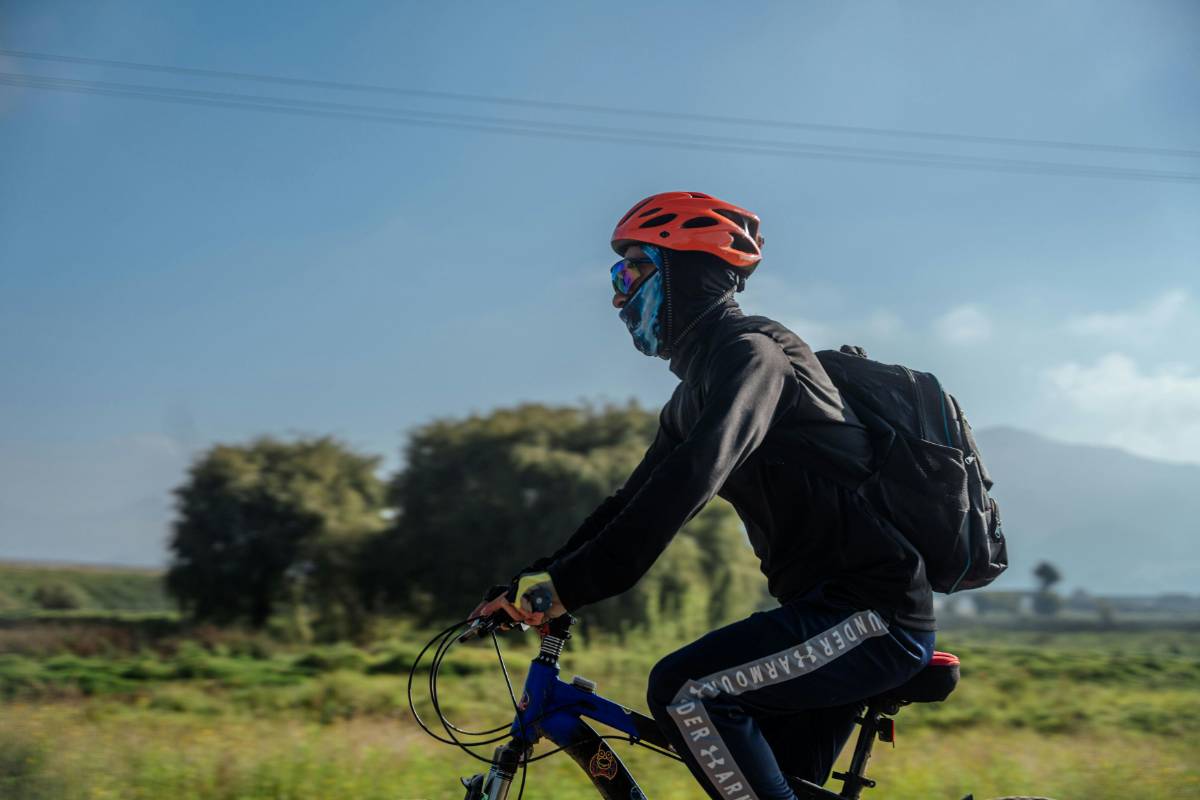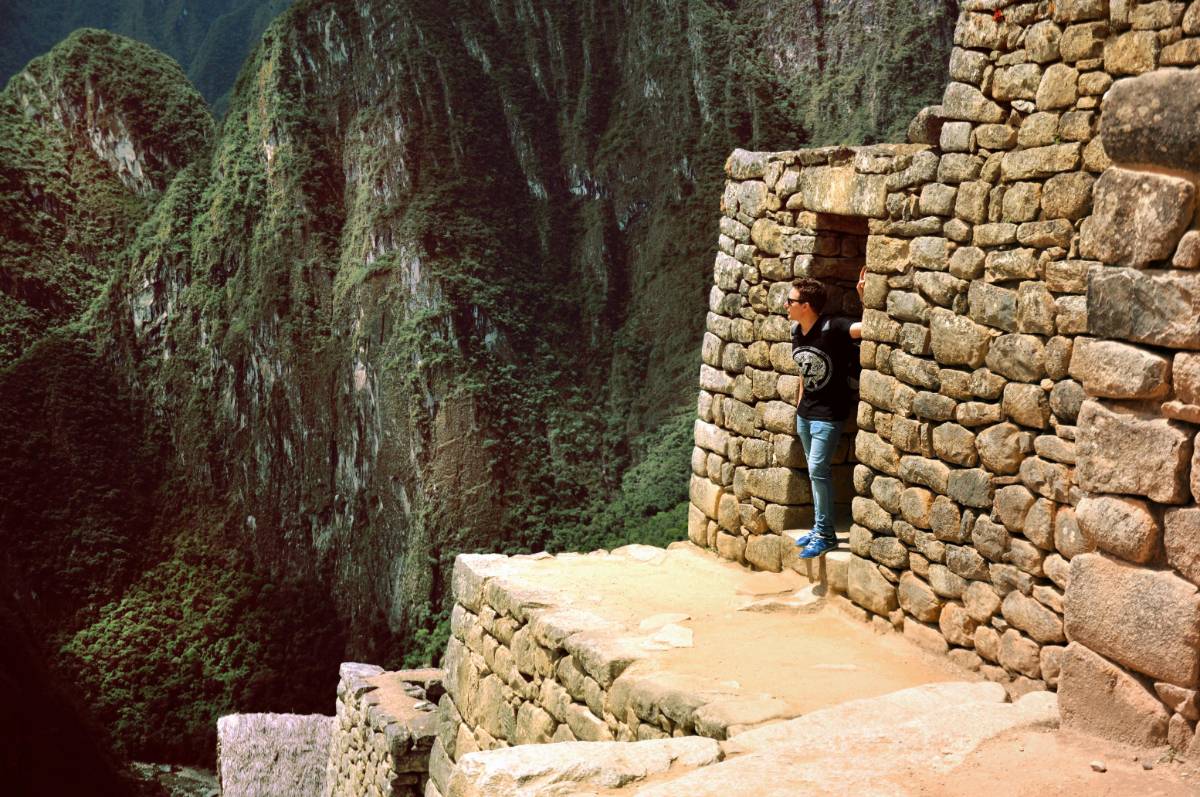
When packing for a trip, be sure to bring along some fitness essentials that can help you stay active no matter where you are. Resistance bands, a jump rope, or a yoga mat are lightweight and versatile items that take up minimal space in your luggage but provide great workout options.
By Abraham Benjamin · 06 Aug 2025
Staying fit and healthy while traveling can be challenging, especially when you’re constantly on the move. However, with a bit of planning and mindfulness, you can maintain your fitness routine and stick to healthy habits no matter where you are. Here are some practical tips to help you stay in shape while on the go.
 Pack Fitness Essentials
Pack Fitness EssentialsWhen packing for a trip, be sure to bring along some fitness essentials that can help you stay active no matter where you are. Resistance bands, a jump rope, or a yoga mat are lightweight and versatile items that take up minimal space in your luggage but provide great workout options.
If you have a favorite pair of running shoes, bring them along so you can enjoy outdoor activities like jogging or walking. These simple items can make a big difference when it comes to maintaining your fitness routine while traveling.
Stay Active During TravelLong flights, train rides, or car trips can make it easy to become sedentary. However, there are small ways to stay active even during transit. Walk around the airport or station when you have a layover, or perform seated exercises while on a plane. Stretching your legs and getting the blood flowing can help reduce stiffness and improve circulation.
If you're traveling by car, take breaks every couple of hours to stretch or walk around. These small activities help keep your body engaged and prevent you from feeling sluggish after long stretches of sitting.
Most hotels now offer fitness facilities that can help you stay on track with your exercise routine. Even if the gym is small, you can still get in a quick cardio or strength workout. If the hotel lacks a gym, look for alternative options, such as outdoor running paths or local fitness centers that offer day passes.
Many hotels also provide fitness classes, which can be a fun way to try something new while staying active during your trip.
One of the best ways to stay fit while traveling is to immerse yourself in local outdoor activities. Whether it’s hiking in the mountains, biking through the city, or swimming in the ocean, these activities offer a fun and unique way to stay active while exploring new places.
Look up local trails, parks, or recreational areas that are within walking distance of where you’re staying. Engaging in outdoor sports or activities can also help you better connect with the destination while keeping your body in motion.
 Choose Healthy Food Options
Choose Healthy Food OptionsEating healthy while traveling can be challenging, especially when tempted by local delicacies or fast food. However, it's possible to make healthier food choices by being mindful of your meals. Look for restaurants that offer fresh, whole foods like fruits, vegetables, lean proteins, and whole grains.
If you're in a city, try visiting local markets or grocery stores to pick up healthy snacks and ingredients for quick meals. Having access to your own food allows you to control portion sizes and avoid unhealthy temptations.
Also, be mindful of portion sizes when dining out, as restaurant servings can often be larger than necessary. Opt for smaller portions or share meals with fellow travelers to avoid overeating.
Stay HydratedMaintaining hydration is crucial for your overall health and fitness. When traveling, it can be easy to forget to drink enough water, especially if you’re distracted by sightseeing or activities. Carry a reusable water bottle with you and make a conscious effort to stay hydrated throughout the day.
Dehydration can lead to fatigue, muscle cramps, and digestive issues, so drinking plenty of water will help you feel your best while on the road.
Get Enough SleepAdequate sleep is essential for maintaining your health and fitness. Travel can disrupt your sleep schedule, but prioritizing rest can help you feel energized and stay on top of your fitness goals.
Create a relaxing bedtime routine to wind down after a day of travel. Avoiding screen time before bed, creating a comfortable sleep environment, and sticking to a consistent sleep schedule can help you get the rest you need, even in new environments.
Incorporate Mini WorkoutsIf you're pressed for time while traveling, try incorporating mini workouts into your daily routine. These short, high-intensity workouts can be done in your hotel room or at a nearby park. For example, a quick 10-minute bodyweight circuit, such as squats, lunges, push-ups, and planks, can help you stay strong and fit while on the go.
Mini workouts can be especially useful when you're traveling for business or have a busy itinerary, allowing you to get in some exercise without taking up too much time.
ConclusionStaying fit and healthy while traveling doesn’t have to be difficult. By incorporating small changes into your routine, such as packing fitness gear, staying active during transit, eating healthy, and prioritizing sleep, you can maintain your health and fitness goals while exploring new places. Remember to enjoy your trip, but also take care of your body so you can make the most of your travel experience.
Subscribe to our newsletter to get our newest articles instantly!

Senior Contributor
Abraham Benjamin is passionate about impactful storytelling. With a unique voice and deep insights, they turn everyday stories into compelling reads that resonate and inform.
Read Full Bio
Traveling to destinations that are home to indigenous cultures offers a unique and enriching experience. By immersing yourself in these diverse traditions and lifestyles, you can gain a deeper understanding of the world. However, it’s crucial to approach these travels with respect and awareness, ensuring that your presence supports and honors the indigenous communities. Here are some must-visit destinations, as well as tips on how to travel responsibly when exploring indigenous cultures.1329a.jpg***Machu Picchu, Peru: Inca Heritage and Spiritual ConnectionMachu Picchu, located in the Andes Mountains of Peru, is one of the most iconic sites that highlights the rich history of the Inca civilization. The indigenous Quechua people still inhabit many regions surrounding the sacred valley, and their culture remains a vital part of the Peruvian identity.When visiting Machu Picchu, it’s important to respect local customs, support indigenous-run businesses, and learn about the spiritual significance of the site. Engage with local Quechua guides who can share insights about the history, culture, and traditions of their people. By doing so, you'll gain a deeper understanding of the site’s importance while helping preserve the region’s cultural heritage.***The Maori Culture, New Zealand: A Rich Legacy of TraditionNew Zealand is home to the indigenous Maori people, whose traditions and language are deeply embedded in the country’s identity. The Maori culture is known for its art, dance (haka), and intricate carvings, and is an integral part of New Zealand’s tourism landscape.To experience the Maori culture, consider visiting the Rotorua region, where visitors can experience traditional feasts, arts, and performances. Be respectful by learning a few words in te reo Maori, the indigenous language, and by participating in cultural activities with an open heart. Responsible tourism is key—support local Maori-owned businesses and ensure that your visit helps preserve the culture for future generations.1329b.jpg***Aboriginal Culture, Australia: Ancient Traditions and Connection to LandAustralia’s Aboriginal peoples have a rich and ancient history that dates back tens of thousands of years. The connection to the land and natural world is at the heart of Aboriginal culture, and visitors can learn about their deep spiritual ties to the earth through art, storytelling, and guided tours.To experience Aboriginal culture responsibly, visit regions like the Northern Territory, where you can explore sacred sites like Uluru (Ayers Rock) and learn about the indigenous stories connected to these landscapes. Always approach these sacred places with respect, and follow the guidance of Aboriginal guides who can share their traditions in an informed and respectful manner.***The Native American Experience, United States: History and Cultural PreservationThe United States is home to over 500 federally recognized Native American tribes, each with its unique history, language, and traditions. From the Navajo Nation in the Southwest to the Lakota Sioux in the Great Plains, there are countless opportunities to explore Native American culture.When traveling to Native American reservations or cultural centers, it’s essential to engage respectfully and learn about their history, challenges, and contributions to society. Visit museums, attend cultural events, and support native artisans and local businesses. Responsible tourism can help support these communities while preserving their cultural heritage.***The Sami Culture, Scandinavia: Reindeer Herding and Arctic TraditionsThe Sami people are the indigenous group of the Arctic regions of Norway, Sweden, Finland, and Russia. Traditionally, they are known for their reindeer herding and unique lifestyle that is deeply tied to the harsh, beautiful Arctic environment.To experience Sami culture, visit regions like Sweden’s Lapland or Norway’s Finnmark. There, you can learn about traditional Sami practices, stay in indigenous-owned lodges, and take part in reindeer herding activities. Ensure that your visit respects their way of life and supports the Sami community’s efforts to maintain their traditions while adapting to modern times.***Responsible Tourism TipsWhen traveling to indigenous communities, it’s vital to adopt a responsible approach that supports the local culture, environment, and economy. Here are a few tips for responsible tourism when exploring indigenous cultures:Respect local customs and traditions: Take time to learn about the culture you are visiting and follow local etiquette. Be mindful of sacred sites and always ask for permission before taking photographs.Support indigenous businesses: Choose tours, accommodations, and restaurants run by indigenous people to directly contribute to their communities.Leave no trace: Be conscious of your environmental impact. Stick to marked trails, avoid littering, and be mindful of the flora and fauna around you.Learn from locals: Engage with indigenous guides and community members to gain a deeper understanding of their history and culture. Listen to their stories and be respectful of their perspectives.***ConclusionExploring indigenous cultures offers an enriching and transformative experience, but it’s important to approach these travels with respect and mindfulness. By following responsible tourism practices, you can ensure that your visit supports and respects the traditions, culture, and livelihoods of the indigenous communities you encounter. Remember, responsible tourism is about making a positive impact and helping to preserve these cultures for future generations.
By Robert Anthony Brown · 13 Aug 2025

There’s something magical about a beach destination that invites relaxation, with its calming waves, warm sands, and the gentle rustling of palm trees. From secluded shores to luxurious resorts, here’s a guide to some of the most unforgettable beach destinations that guarantee the ultimate relaxation experience.1162a.jpg***The Caribbean Charm of Turks and CaicosWith its stunningly clear waters and soft, white sands, Turks and Caicos is a go-to for anyone looking for a picture-perfect beach escape. Grace Bay Beach is particularly famous, offering 12 miles of uninterrupted coastline with minimal crowds, calm waves, and ample sun. Luxury resorts line the shores, catering to visitors who seek both comfort and serenity.Visitors to Turks and Caicos can indulge in spa treatments, local cuisine, and water activities like snorkeling and paddleboarding. For those who prefer to relax with a view, several beachfront cafes and lounges provide a perfect setting for soaking in the island’s natural beauty.***The Serenity of the MaldivesThe Maldives remains a top choice for travelers seeking seclusion and peace. Known for its overwater bungalows, clear lagoons, and coral reefs, each island resort offers its private paradise, free from crowds and filled with luxurious amenities. You can wake up to panoramic views of the ocean, enjoy spa treatments on the beach, and unwind with yoga sessions by the water.Beyond relaxation, the Maldives offers fantastic snorkeling and diving experiences. The reefs are home to vibrant marine life, including rays, turtles, and an array of colorful fish. For ultimate tranquility, consider booking a private villa, where you can have your own slice of paradise all to yourself.***Bora Bora, French Polynesia: The Jewel of the PacificBora Bora is synonymous with romance and relaxation. Known for its turquoise lagoons, coral reefs, and luxury resorts, this destination is ideal for those looking to unwind and reconnect. With private beaches, clear blue waters, and lush mountains, Bora Bora offers a mix of relaxation and natural beauty that is hard to match.Luxury overwater bungalows are a highlight in Bora Bora, offering direct access to the lagoon and breathtaking sunset views. Enjoy leisurely days kayaking, snorkeling, or simply soaking up the sun on the beach. For those seeking adventure, a hike up Mount Pahia provides panoramic views of the entire island, making it a must-visit for nature enthusiasts.***Santorini, Greece: Cliffside Beauty and TranquilitySantorini’s beaches may be unique with their volcanic black and red sands, but its serene views and charming atmosphere make it a top destination for relaxation. Known for its whitewashed buildings, cliffside views, and vibrant sunsets, Santorini offers an unforgettable experience with a mix of beach relaxation and cultural exploration.Visitors can relax on Perissa Beach, known for its black sand and tranquil setting, or explore the cozy streets of Oia. As one of Greece’s most iconic islands, Santorini offers a blend of laid-back beach vibes with a touch of Mediterranean charm. Luxurious villas overlooking the sea are a popular choice for a relaxing stay.1162b.jpg***The Undisturbed Beauty of SeychellesSeychelles is an idyllic choice for travelers seeking quiet, undisturbed beach time. Known for its lush landscapes, granite boulders, and crystal-clear waters, Seychelles offers a wide array of beaches, from the remote Anse Source d’Argent to the luxurious shores of Beau Vallon. Each beach offers its unique charm, but all are marked by calm waters and minimal crowds.Beyond the beaches, Seychelles is also known for its abundant wildlife, including giant tortoises. For an exclusive experience, visitors can book private villas or stay at one of the many eco-friendly resorts that cater to sustainable tourism, allowing you to relax while supporting the environment.***Phuket, Thailand: A Tropical GetawayPhuket, Thailand’s largest island, is famous for its vibrant beaches, luxury resorts, and relaxed vibe. Patong Beach and Kata Beach are popular spots for tourists, but quieter beaches like Nai Harn and Freedom Beach offer a more secluded escape. Thailand’s warm culture and exotic cuisine enhance the tropical relaxation experience.For those interested in wellness, Phuket offers a range of spa treatments, beachfront yoga, and meditation centers. Additionally, the surrounding islands, including the Phi Phi Islands, provide day trip opportunities for snorkeling, diving, and exploring turquoise waters.***Maui, Hawaii: Where Nature Meets RelaxationMaui provides a blend of relaxation and adventure with its golden sands, lush jungles, and volcanic landscapes. From the famous Wailea Beach to the picturesque Ka’anapali Beach, Maui offers an array of options for beach lovers. Whether you want to unwind by the shore, explore marine life while snorkeling, or indulge in local Hawaiian cuisine, Maui has something for everyone.For a unique experience, drive along the Hana Highway, where you can enjoy stunning views of waterfalls, lush greenery, and ocean cliffs. Maui also offers luxurious resorts with spa facilities, making it easy to relax and rejuvenate while immersed in the island’s natural beauty.***The Allure of the Amalfi Coast, ItalyThe Amalfi Coast is renowned for its dramatic cliffs, colorful villages, and picturesque beaches. Places like Positano and Ravello are favorites among travelers looking to unwind in a stylish yet tranquil setting. The beaches are pebbled and surrounded by charming towns, offering both relaxation and cultural exploration.For a relaxing stay, book a seaside villa where you can enjoy spectacular views of the Mediterranean Sea. Enjoy local Italian cuisine, sunbathe on the beach, or take a boat trip along the coast. The Amalfi Coast blends elegance and natural beauty, making it a top choice for those seeking a sophisticated beach getaway.***Conclusion: Finding Your Perfect Beach EscapeWhether you’re looking for the secluded luxury of the Maldives, the dramatic cliffs of Santorini, or the cultural charm of the Amalfi Coast, there’s a beach destination out there for every type of traveler. Each of these destinations offers a unique experience, allowing you to unwind, recharge, and immerse yourself in the natural beauty of your surroundings. Embrace the relaxation and adventure that comes with a beach getaway, and discover the joy of escaping to one of these unforgettable beach destinations.
By Robert Anthony Brown · 06 Aug 2025

When traveling abroad, understanding and respecting local cultural norms is crucial for building positive relationships and avoiding misunderstandings. Every country has its own set of etiquette rules, from greeting customs to dining manners. Familiarizing yourself with these practices can enhance your travel experience and show respect for the culture you’re visiting.1172a.jpg***Step 1: Research Local GreetingsOne of the first things you'll encounter when arriving in a new country is the local greeting. Handshakes, hugs, bows, or even cheek kisses may be the norm, but the way greetings are performed varies widely across cultures.In some countries, such as Japan, bowing is a traditional form of greeting, while in many Western cultures, a firm handshake is the standard. In the Middle East, greetings may include a kiss on both cheeks or a warm hug between close friends. Understanding these customs can help you avoid any awkwardness when meeting new people.***Step 2: Dress Appropriately for the CultureDress codes vary significantly from one country to another, and what's considered appropriate attire in your home country may not be suitable in another. Many cultures have more conservative dress codes, particularly in religious or rural areas.For example, in some Middle Eastern and Asian countries, it’s important to dress modestly, especially when visiting religious sites. In contrast, beach destinations might encourage more casual or relaxed clothing. Always research the dress code for the country you're visiting and pack accordingly to ensure you're respectful of local customs.***Step 3: Understand Table Manners and Dining EtiquetteDining etiquette is one of the most important aspects of cultural etiquette. While a meal in one country may involve formal seating arrangements and specific utensils, in another, it might be a more relaxed, communal experience.In some cultures, like in parts of Asia, it’s common to eat with chopsticks, and there are specific rules on how to use them, such as not sticking them upright in a bowl of rice. In the Middle East, sharing food from a communal plate is common, and in countries like Italy, it’s considered rude to order pasta with cream-based sauces after a certain time of day.***Step 4: Respect Local Religious PracticesReligion plays a central role in many cultures, and understanding local religious practices is important for demonstrating respect. In some countries, it’s crucial to dress modestly when visiting places of worship or to remove your shoes before entering certain areas, like temples or mosques.In predominantly Muslim countries, it’s important to be mindful of prayer times and fasting during Ramadan, when eating or drinking in public during daylight hours may be frowned upon. Always take the time to understand religious observances and be respectful during your travels.1172b.jpg***Step 5: Tipping PracticesTipping customs vary from one country to another. In the United States, tipping is common and expected, but in many European countries, a service charge is often already included in the bill, making tipping optional. In some Asian countries, like Japan, tipping is not a common practice and may even be seen as disrespectful.Before traveling, research the tipping customs in the country you’re visiting. This will help you avoid offending anyone or appearing disrespectful due to cultural differences. Understanding whether or not to tip, and how much, can enhance your experience and show appreciation for the services you receive.***Step 6: Be Mindful of Personal Space and Physical ContactDifferent cultures have different views on personal space and physical contact. In many Western countries, people value personal space and may not be comfortable with close physical contact from strangers. In contrast, cultures in the Mediterranean or Latin America may have a more relaxed view of personal space, and close physical proximity during conversations is more common.It’s important to observe how locals interact with one another and adapt accordingly. While it’s always important to respect boundaries, understanding cultural norms can help you engage more comfortably in social situations.***Step 7: Learn Key Phrases in the Local LanguageAlthough English is widely spoken in many countries, learning a few key phrases in the local language can go a long way in making a positive impression. Simple phrases like "hello," "please," "thank you," and "excuse me" can help break the ice and show that you appreciate the local culture.Learning a few words in the local language demonstrates respect and shows that you’ve made an effort to connect with the people and culture of the country you’re visiting. Locals often appreciate when travelers make the effort, even if it’s just a few basic phrases.***Step 8: Be Aware of Cultural Taboo SubjectsEvery culture has its taboos—subjects or actions that are considered offensive or inappropriate. These can vary widely, so it’s important to do your research before traveling. For example, discussing politics or religion may be a sensitive topic in certain cultures, and making jokes about the monarchy or national symbols can be considered highly disrespectful in others.When traveling, be mindful of these taboos and avoid bringing up potentially offensive subjects unless you are familiar with the cultural context. This helps avoid misunderstandings and ensures that you maintain a respectful attitude throughout your travels.***Step 9: Observe Local Customs and TraditionsIn every country, there are customs and traditions that play an important role in the daily lives of locals. Whether it’s a specific holiday, ritual, or social expectation, take time to learn about these practices and participate when appropriate. Showing genuine interest in local traditions can enhance your experience and demonstrate respect for the culture.Traveling abroad provides an opportunity to immerse yourself in a culture that may be very different from your own. By understanding and respecting local cultural norms, you not only enrich your travel experience but also foster goodwill and create meaningful connections with people you meet along the way.
By Robert Anthony Brown · 16 Aug 2025

Marketplaces are the heartbeat of many cultures around the world. They offer a unique glimpse into local traditions, flavors, crafts, and commerce. From bustling street markets to grand historical bazaars, these iconic marketplaces not only showcase regional products but also provide a cultural experience unlike any other. Here are some of the most famous marketplaces that you should visit on your travels.1317a.jpg***Grand Bazaar, Istanbul, TurkeyOne of the largest and oldest covered markets in the world, Istanbul’s Grand Bazaar is a must-see for any traveler. With over 4,000 shops spread across 61 streets, it offers everything from handmade carpets and Turkish delights to jewelry and spices. The market has been in operation for centuries and is not just a place to shop, but a historical landmark where you can immerse yourself in Turkish culture and tradition.As you wander through the labyrinth of narrow alleys, take time to haggle with shopkeepers, discover antiques, and savor traditional Turkish street food. The Grand Bazaar is a sensory overload of colors, sounds, and smells.***Souk Madinat Jumeirah, Dubai, UAEDubai is known for its modern architecture and luxury shopping malls, but the Souk Madinat Jumeirah offers a more traditional marketplace experience. Located in the shadow of the iconic Burj Al Arab, this bustling souk is designed to mimic an ancient Arabian marketplace with a mix of modern amenities.Here, you can find a variety of goods, including spices, textiles, gold jewelry, and handicrafts. The souk’s picturesque canals and narrow walkways make it a lovely spot to spend an afternoon. It’s a great place to experience Dubai’s heritage while enjoying its contemporary charm.1317b.jpg***Chatuchak Weekend Market, Bangkok, ThailandIf you're in Bangkok, the Chatuchak Weekend Market is a shopping paradise. With over 15,000 stalls, it is one of the largest markets in the world. This sprawling market offers a variety of products, from clothing and antiques to plants and pets. It’s a great place to pick up unique souvenirs and gifts or simply to enjoy the hustle and bustle of Thai street culture.Don’t forget to sample some of the delicious street food available, from pad Thai and mango sticky rice to freshly squeezed juices and grilled meats. Chatuchak is an experience that appeals to all the senses and is a must-visit when in Bangkok.***La Boqueria Market, Barcelona, SpainLa Boqueria is one of Barcelona’s most iconic food markets, and it’s a must-visit for food lovers. Located just off the famous La Rambla, the market offers a vibrant display of fresh produce, meats, seafood, cheeses, and pastries. The colorful stalls are a feast for the eyes, and you’ll find locals and tourists alike shopping for their daily ingredients or grabbing a quick bite at one of the market’s many tapas bars.The market dates back to the 13th century, and its historical significance adds to the charm. Don’t miss the opportunity to try some traditional Catalan specialties, such as jamón ibérico, fresh seafood, and churros.***Marrakech Souks, MoroccoThe souks of Marrakech are a maze of narrow streets and alleys where you can shop for everything from handmade leather goods to intricately designed pottery. Located in the heart of the medina, the souks are a key part of Marrakech’s cultural fabric, offering a sensory journey through Morocco’s rich artisan traditions.The souks are divided into different sections, each dedicated to a specific product, such as spices, textiles, or metalwork. Bartering is a common practice here, so be prepared to negotiate prices with shopkeepers. The bustling atmosphere, the vibrant colors, and the exotic scents make the Marrakech souks an unforgettable experience.***Pike Place Market, Seattle, USAOne of the oldest public markets in the United States, Pike Place Market is a Seattle landmark. It’s known for its fresh seafood, including the famous flying fish, where vendors toss fish to each other as part of their tradition. But Pike Place Market is also home to a variety of other stalls selling flowers, crafts, and local produce.Pike Place Market offers a great introduction to Seattle’s food scene, with numerous cafes and restaurants offering fresh, local ingredients. It’s also a great place to explore the arts, as many local artists sell their works here. Don’t forget to stop by the iconic “gum wall” for a quirky photo opportunity.***Jemaa el-Fnaa, Marrakech, MoroccoAnother highlight of Marrakech’s medina is the Jemaa el-Fnaa square, a bustling marketplace where you can find food vendors, traditional healers, snake charmers, and performers. As the sun sets, the square comes alive with street food stalls offering delicious Moroccan specialties, such as tagine, couscous, and freshly squeezed orange juice.Jemaa el-Fnaa is an atmospheric place where you can immerse yourself in the sights and sounds of Marrakech. The lively atmosphere, combined with the rich history, makes this marketplace an unforgettable experience.***ConclusionWhether you’re shopping for fresh ingredients, unique souvenirs, or simply soaking in the local culture, iconic marketplaces around the world offer travelers an unforgettable experience. From the centuries-old markets of Istanbul and Marrakech to the vibrant stalls of Bangkok and Barcelona, each marketplace has its own charm and story to tell. Make sure to add these destinations to your travel list and experience the magic of these bustling bazaars firsthand.
By Stefen · 18 Aug 2025